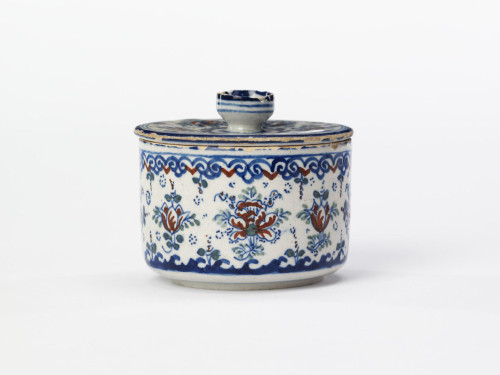509/2011
Collection
Ceramics
Brief description
Tin-glazed earthenware sugar pot and cover with polychrome painted decoration of stylised peonies and tulips with scrolling and wave-like borders, probably manufactured in Vauxhall, c.1715-20.
Object name
Sugar pot
Object number
509/2011
Production date
c.1715-20 (manufactured)
Period
Georgian (1714-1837)
Material
earthenware
tin glaze
tin glaze
Technique
glazed
painted
thrown
painted
thrown
Physical description
Tin-glazed earthenware sugar pot and cover. The body of the pot is cylindrical with a foot-rim; painted in blue, red and green with a repeating band of alternating flower heads, stylised peonies and tulips, leafy sprigs and circles of small dots. There is a wave-like blue border at the foot and a blue scrolling border with red V shapes at the rim.
The disc-shaped cover has a low, hollow knop on a thick stem, and is painted with decoration to match that on the body of the pot, with three repeats of the flowers, a wavelike border painted around the foot of the knop and a border of three concentric rings painted in blue at the rim.
The disc-shaped cover has a low, hollow knop on a thick stem, and is painted with decoration to match that on the body of the pot, with three repeats of the flowers, a wavelike border painted around the foot of the knop and a border of three concentric rings painted in blue at the rim.
Dimensions
Height: 5.2cm
Diameter: 5.5cm
Diameter: 7.2cm
Diameter: 8cm
Height: 2cm
Diameter: 5.5cm
Diameter: 7.2cm
Diameter: 8cm
Height: 2cm
Website keywords
serving drink
tea, coffee and chocolate drinking
tea, coffee and chocolate drinking
Label
Label text for the exhibition At Home with the World, Geffrye Museum (20 March 2012- 9 September 2012):
Sugar pot
Behind this eighteenth-century earthenware sugar pot is an appalling story of human suffering. Europeans’ newfound passion for bitter-tasting hot drinks (tea, coffee and chocolate) demanded sugar as a sweetener. The cost of satisfying this sweet tooth was borne by Africans shipped in inhuman conditions in their millions to the Caribbean, to labour on sugar plantations as an enslaved workforce.
Sugar pot
Behind this eighteenth-century earthenware sugar pot is an appalling story of human suffering. Europeans’ newfound passion for bitter-tasting hot drinks (tea, coffee and chocolate) demanded sugar as a sweetener. The cost of satisfying this sweet tooth was borne by Africans shipped in inhuman conditions in their millions to the Caribbean, to labour on sugar plantations as an enslaved workforce.












